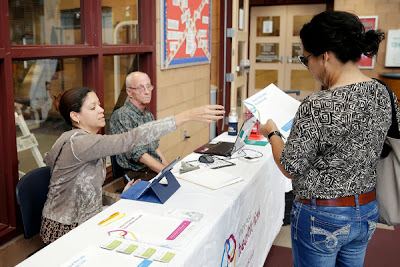 |
| health care |
“I am thrilled,” Ms. Skrebes said, referring to her policy. “It’s affordable, good coverage. And the Web site of the Minnesota exchange was pretty simple to use, pretty straightforward. The language was really clear.”
The experience described by Ms. Skrebes is in stark contrast to reports of widespread technical problems that have hampered enrollment in the online health insurance marketplace run by the federal government since it opened on Oct. 1. While many people have been frustrated in their efforts to obtain coverage through the federal exchange, which is used by more than 30 states, consumers have had more success signing up for health insurance through many of the state-run exchanges, federal and state officials and outside experts say.
Alan R. Weil, the executive director of the National Academy for State Health Policy, an independent nonpartisan group, credited the relative early success of some state exchanges to the fact that they could leap on problems more quickly than the sprawling, complex federal marketplace.
“Individual state operations are more adaptable,” Mr. Weil said. “That does not mean that states get everything right. But they can respond more quickly to solve problems as they arise.”
In addition, some states allow consumers to shop for insurance, comparing costs and benefits of different policies, without first creating an online account — a barrier for many people trying to use the federal exchange.
The state-run exchange in New York announced Tuesday that it had signed up more than 40,000 people who applied for insurance and were found eligible.
“This fast pace of sign-ups shows that New York State’s exchange is working smoothly with an overwhelming response from New Yorkers eager to get access to low-cost health insurance,” said Donna Frescatore, the executive director of the state exchange.
In Washington State, the state-run exchange had a rocky start on Oct. 1, but managed to turn things around quickly by adjusting certain parameters on its Web site to alleviate bottlenecks. By Monday, more than 9,400 people had signed up for coverage. The Washington Health Benefit Exchange does not require users to create an account before browsing plans.
“The site is up and running smoothly,” said Michael Marchand, a spokesman for the Washington exchange. “We’re seeing a lot of use, a lot of people coming to the Web site. If anything, I think it’s increasing.”
Other states reporting a steady stream of enrollments in recent days include California, Connecticut, Kentucky and Rhode Island.
In Connecticut, a spokesman for the state-run exchange, Access Health CT, said users have generally had a smooth experience with the Web site other than “a couple of bumps and hiccups on the first day.”
By Monday afternoon, the Connecticut exchange had processed 1,175 applications, said the spokesman, Jason Madrak.
Daniel N. Mendelson, the chief executive of Avalere Health, a research and consulting company, said: “On balance, the state exchanges are doing better than the federal exchange. The federal exchange has, for all practical purposes, been impenetrable. Systems problems are preventing any sort of meaningful engagement.”
“By contrast,” said Mr. Mendelson, who was a White House budget official under President Bill Clinton, “in most states, we can get information about what is being offered and the prices, and some states are allowing full enrollment. All the state exchanges that we have visited are doing better than the federal exchange at this point.”
In California, Peter V. Lee, the executive director of the state-run exchange, said that more than 16,000 applications had been completed in the first five days of open enrollment. Mr. Lee said that while the consumer experience “hasn’t been perfect,” it has been “pretty darn good.”
Some state-run exchanges have run into difficulties because they rely on the federal marketplace for parts of the application process, like verifying an applicant’s identity. Minnesota, Nevada and Rhode Island are among the states that have reported problems with the “identity-proofing” process, which requires state-run exchanges to communicate with the federal data hub.
Brandon Hardy, 31, of Louisville, Ky., was one of the first to sign up for health insurance through Kentucky’s state-run exchange, working with an application counselor who guided him through the process last Wednesday. Mr. Hardy, who is uninsured and has epileptic seizures that land him in the hospital every few months, spent about 45 minutes filling out the online application, and learned that he would be eligible for Medicaid under the health care law.
“It was pretty easy,” Mr. Hardy said of the process. “What I really need is a neurologist, and now hopefully that will happen. This is like a huge relief.”
Attempts to sign up for coverage through the federal marketplace have often proved more frustrating.
Bruce A. Charette, 60, of Tulsa, Okla., said he had been trying to log onto the Web site for the federal exchange since last Wednesday, but had not been able to see the available plans or their rates.
Mr. Charette said he was asked verification questions that did not appear to match his identity. One question, he said, asked about the name of a pet for which he had purchased health insurance two years ago. “I don’t have any pets,” he said.
“It’s obvious that the site is overloaded,” said Mr. Charette, an electrician who works in the aviation industry and said he did not have health insurance. “I am not going to stare at a computer screen for 45 minutes, waiting for a response. It looks as if the Web site is freezing up.”
Still, some groups helping people sign up for insurance through the federal marketplace said they were finally able to complete applications on Tuesday, a week into open enrollment.
“This was the first day that I have been able to get onto the Web site and sign people up,” said Laura Line, corporate assistant director for Resources for Human Development in Philadelphia, which has a contract to help people in Southeastern Pennsylvania enroll in health plans through the federal exchange. “We have been setting appointments and answering a ton of phone calls now that we are able to do something.”
 6:25 AM
6:25 AM
 World news & wallpaperz
World news & wallpaperz








.jpg)




















.jpg)
.jpg)
.jpg)

.jpg)